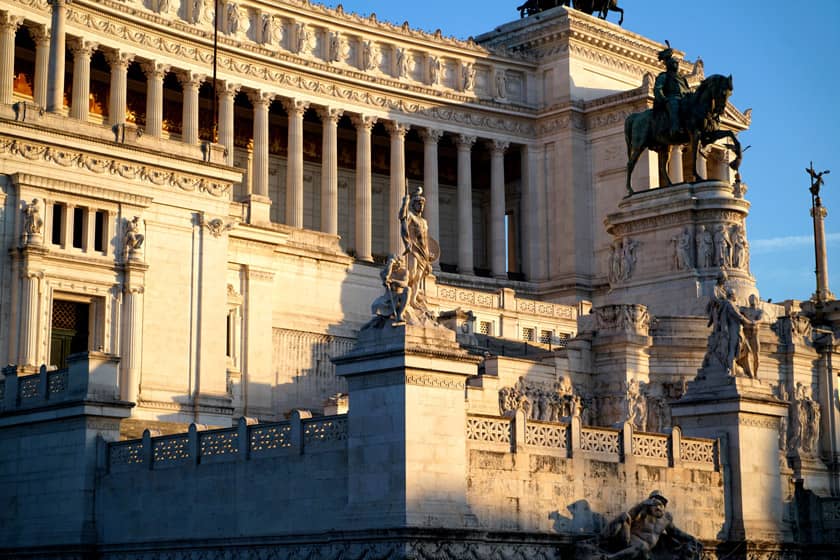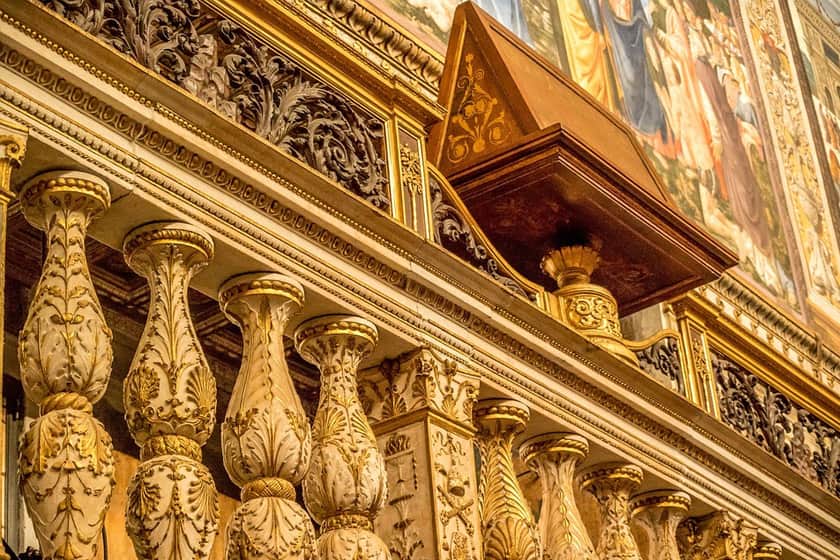Rome is unique, a fact visible if you take a look at the map of Rome. No other city can match the architectural, artistic, and historical riches, and no other city can offer walks in such breathtaking places. To visit only the marked places, you need a few days.
As seen in the map of Rome, you will also be hit by the shortcomings of the modern age – a lot of noise, congested traffic, and pollution. At first glance, especially in the suffocating summer, she is too agitated to feel good. If these statements seem out of place, take them as a warning – it’s easy to forget that Rome has a troubled present, not just a glorious past.
General Information about Rome and the map of Rome
As you can see on the map of Rome, the best approach to the city is an indirect one. Avoid rushing from the very beginning to the big tourist objectives that are advertised in abundance and relax with a coffee or a short walk through the squares.
Navona Square and Campo de Fiori are two of the best choices. Remember that enjoying a city does not just mean seeing as many monuments as possible. So give yourself time to wander through these areas, or others like Trastevere and Ghetto, two of the old neighborhoods worth seeing.
When you are ready to visit tourist attractions, a good map and a minimum sense of direction will take you to the desired place, because in the old town it is not difficult to find your way.
It starts with Piazza Venezia, located approximately in the city center. Very visible is the Monument of Victor Emmanuel II, a colossal altar dedicated to the unification of Italy, where the tomb of the Unknown Soldier is located.
The monument is flanked by Capitol Hill, the heart of the old city. Three main roads start from the square, each being a suitable route for visiting expeditions.
Eastern Artery
The first is the Via dei Fori Imperiali, which goes south, passing the Roman Forum and the Colosseum, two of Rome’s main attractions. The road also offers easy access to the Imperial Forum, San Pietro in Vincoli (famous for Michelangelo’s statue of Moses), and two of the most interesting churches, San Clemente and San Giovanni in Laterano. As you can see on the map of Rome above, all these objectives can be easily seen in one day, although the most important church in this neighborhood, Santa Maria Maggiore, is in a more isolated place, in a not very pleasant area near Termini, the most important train station in Rome.
Western Artery
From the west of Piazza Venezia, starts Corso Victor Emmanuel II, the second main artery of Rome, which passes directly through what is often called the “Medieval and Renaissance heart” of the city. In fact, as everywhere in Rome, the neighborhood it divides – the most interesting, by the way – is a heterogeneous mix of monuments from all eras.
The strong points are the Doria Pampilj Palace, one of the most famous art galleries in the city, and two large squares: Navona Square and Campo de Fiori.
There are all kinds of churches and palaces on the map of Rome, but also countless other old buildings among which you sneak on winding streets are scattered in the area and you could spend a few days exploring just this neighborhood. If you don’t have much time, just visit the Pantheon, the best-preserved ancient monument in Rome, and the churches of San Luigi dei Francesi and Santa Maria Sopra Minerva.
Northern Artery
An almost equally attractive area stretches along the third artery of Piazza Venezia, Via del Corso, which goes north. The side streets hide well-known attractions, such as the Trevi Fountain and the Spanish Steps, not to mention the Barberini Palace (an important museum), and a network of streets around Via Condotti that make this neighborhood the best shopping area. At the northern end, Corso opens into Piazza del Popolo (People’s Square), beyond which lies Villa Borghesse (paintings and sculptures) and Villa Giulia (ancient art and artifacts).
Take a look at the other side of the river Tiber on the map of Rome, the main river of Rome. You will see the Basilica of San Pietro, which takes half the day to visit, including an hour to spend nearby, at the Castle of San Angelo. Also in this area, in the small independent Vatican State, are the Vatican Museums (where the Sistine Chapel is) and the largest museum complex in the world.
The map of Rome: Walk through Medieval Rome
This tour, starting from Piazza Colonna, will explore the most enchanting side streets, taking you slowly through the artisans’ neighborhoods and through the old Ghetto, will cross the Tiber to end in the bohemian atmosphere of the Trastevere district.
It starts from Piazza Colonna (1), named after the Colonna di Marco Aurelio (Column of Marcus Aurelius), a column decorated with bas-reliefs built in the second century to celebrate the military triumph of Emperor Marcus Aurelius. Beyond the column stands Bernini’s work, Palazzo di Montecitorio (1650), now the seat of the lower house of parliament. Head west on Via Uffici di Vacario, past the old Caffe Giolitti at number 40, to reach Sant’Agostino, the Renaissance-style church on Via della Scrofa, famous for its paintings by Caravaggio and Raphael. Several canvases of the former are exposed in San Luigi dei Francesi (2) to the south, from where you should go on Via Giustiniani, to the east, to visit the Pantheon (3) and Santa Maria Sopra Minerva (4).
From Piazza della Rotonda, just after the Pantheon, head west towards Corso Rinascimento, passing through Piazza San’Eustachio. On the way, do not miss the Palazzo della Sapienza, through the courtyard of which you enter San’Ivo alla Sapienza (1642-1660), a church with an eccentric appearance – the tower is twisted and its top has a white shape – designed by Francesco Borromini. Cross Corso and enter Piazza Navona (5), leaving the square halfway in its western part, on Via di Tor Millina. The bar at the end of the street, Bar della Pace, is an attractive place, suitable for a coffee break.
Go north to Via dei Coronari, a street famous for its antique shops. Head west until you meet Via del Panico, where you should turn left and turn onto the side streets to Chiesa Nuovo (6), a church famous for its Rubens paintings and a baroque fresco painted by Pietro da Cortona. Cross Corso Vittorio Emanuelle II in front of the church and go straight ahead, then turn left onto Via del Pellegrino and almost immediately turn right onto Via del Cappellari. Full of dusty furniture workshops, it offers a picturesque image of ancient Rome.
Continue on this street at Campo de Fiori (7), then turn right into Piazza Farnese. From the southern corner of the square, take Via di Monserrato and reach the Palazzo Spada (Piazza Cappo di Ferro), famous for its beautifully decorated facade, a modest art gallery, and Borromini’s work, trompe l’oeil colonnade (a corridor bordered by columns, made to look longer than it is).
Turn left onto Via Arco del Monte, then right onto Via Giubbonari. Cross Via Arenula and walk along Via dei Falegnami to the crossroads that once made up the Jewish Ghetto. In Piazza Mattei, just below, on the street, is one of the most charming fountains in the city, Fontana delle Tartarughe (1581), named after the funny bronze statue of Bernini, tartarughe (turtle).
Take a right towards the square at the southern end, then turn left onto Via del Portico d’Ottavia, a street named after the Roman ruins at the eastern end, which were once portico (entrance) in a huge temple complex and libraries. Go down the street to the corner, turn right, pass the most famous synagogue in Rome, and the circular walls of the Teatro di Marcello (8), a first-century amphitheater, later covered by medieval houses.
Cross the street on the banks of the Lungotevere River and walk along Ponte Fabricio to Isola Tiberina (9), the only island on the Tiber that was donated to a hospital in 1538. Wander the streets of the island and stop at the Church of San Bartolomeo, built in the 11th century over a pagan temple of Aesculapius, a god with healing powers.
Cross the Ponte Cestio to the district known as Trastevere (over the Tiber). A working-class neighborhood, it is now a picturesque area, famous for its restaurants and nightlife, although the most fashionable clubs and bars are moving further and further south, to an area called Testaccio. Beyond Lungotevere, going south on Via Anicia from Piazza in Piscinula, admire the Church of Santa Maria in Trastevere (10), another church full of beautiful mosaics located in a charming square, in the heart of the Trastevere district.
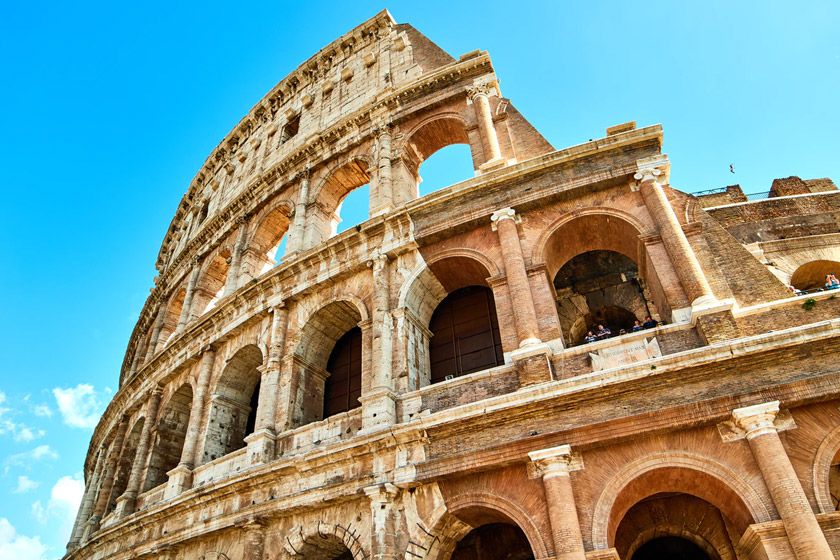
Map of Rome: The Colosseum
One of the most iconic tourist attractions on the map of Rome is The Colosseum. It is the largest surviving Roman construction. Its majestic effect has not diminished over time, nor as a result of the damage caused by the traffic around it. Once upon a time, its walls resounded with gladiator fights and the cries of the crowd, and later with the beating of hammers that knocked it down, to use the stone to build medieval churches and palaces. Today, its walls are still standing, despite the vicissitudes, defying the famous prophecy that said, “As long as the Colosseum is standing, Rome will resist. When the Colosseum falls, Rome will collapse; when Rome falls, the world will fall.”
The construction of the Colosseum began in the year 70, from the desire of the emperor Vespasian to have a monument to celebrate his military triumph in the Middle East. Unfinished until his death in 79, construction was continued by Vespasian’s son Titus. The inauguration of the Colosseum took place in the year 80. The last touches were made by the successor of Titus, Domitian (81-96), who was a member of the Flavius dynasty, like his predecessors. Therefore, the arena was initially called Amphitheatrum Flavianum. The name he later had could simply come from the shape it has, or, more likely, due to the nearby location (no longer exists today) of the colossal bronze statue of Nero, once the largest in the world.
The massive size of the Colosseum raised significant engineering problems, not to mention those related to the swampy land on which it was to be built. But the place was chosen because it was close to the Forum and the Palatine Hill. Before the construction of the Colosseum, on that land had been an artificial lake and the famous villa of Nero, Domus Aurea, or the Golden House. Huge drainage channels, many still existing, formed a honeycomb in the foundation, while huge amounts of volcanic tuff and cement-clad bricks were used to build the walls. Over one hundred thousand cubic meters of travertine lined the outer wall, a decorative veneer was fixed with over three hundred iron brackets (these were removed in 664, hence the traces that can be seen on the outer wall).
At the end of the construction, the amphitheater was a model of simplicity and functionality, becoming not only a model for other Roman amphitheaters but also for many stadiums of the modern era. About 50,000 spectators could enter or exit any of the 50 vomitings, or exits, while 240 wooden pillars fixed on the top row supported a massive net on which canvas was fixed. This velarium was maneuvered by sailors from the empire’s fleet. The sand was sprinkled on the floor, so that the gladiators would not slip and so that the blood of the fighters would be absorbed (the word arena [sand] will be used from this moment to designate the venue of a show). All sorts of tunnels passed under the arena, pulleys, and elevators allowed animals and fighters to be brought into the arena, while pipes and aqueducts were used to flood the arena, to allow the development of naumachiae, parodies after naval battles.
The building deteriorated rapidly. In the year 240, a fire destroyed most of the area of the stage and the upper places, especially since they were mostly built of wood. Later conflagrations and earthquakes continued to destroy it for the next two centuries. After the fall of the Roman Empire, a small church was built next to it, and the tribune area was used as a cemetery. Some parts of the monument became a fortress, others, houses, or shops. The stone was looted mercilessly, finding its use in Palazzo Farnese, Palazzo Venetia, Palazzo Barberini, and many other smaller palaces, churches, and, later, bridges. Two-thirds of the monument has disappeared over the years, and it would have been much more if Pope Benedict XIV, who declared the place sacred, in memory of Christians who were supposed to have been killed here, had not stopped the massacre.
The next popes and administrators began a process of restoration, excavation, and consolidation that continues today.
One of the myths of the Colosseum that continues today – that the rain was red from the blood of Christian martyrs – is just an invention. Evidence suggests that very few Christians were killed here (probably none), with religious persecution during the Roman Empire taking place during Nero’s reign, 30 years before the arena was built. But it is certain that a lot of people died here.
Initially, gladiators fought in ritual battles, in order to prepare for the actual wars, this practice being inherited by the Romans from the Samnites or Etruscans. In Vespasian’s time, the custom was popularized, competitions, or “munera” (“respectful gifts”), testifying to the decline of a population that, in Juvenal’s famous remark, sold its soul for free food and entertainment, or “Panem et circenses” (bread and circus). At first, the events were sponsored by various people, but since the reign of Domitian, competitions have become so vital that they have come to be considered a gift that only the emperor could give to the people.
The competitions usually took place according to a certain schedule. First came “venationes”, or animal hunters: Trajan’s victory in Dacia, in 107, was followed by 123 days of competition, in which there were over 10,000 gladiators and 10,000 animals were killed. Then there were the public crimes, often preceded by torture races and executed with horrible and complicated tools.
Lots of ingenious variations were used to spice up the competitions. Men, women, and animals fought against each other. Criminals and slaves often fought together against death, while spectators bet on the outcome of the race. Slaves could be won in an imperial lottery, while spectators had the fate of the fighters in their hands – literally. A handkerchief fluttering in the air meant salvation. Another gesture, famous and very common, the thumb pointing down meant death. The survivors were often beheaded and the dead were stung to make sure they were no longer alive. Gladiator competitions survived until 438, and the last animal extravaganza took place in 523.
Make sure to mark the location of The Colosseum (if you don’t use our map) on your map of Rome and travel itinerary.
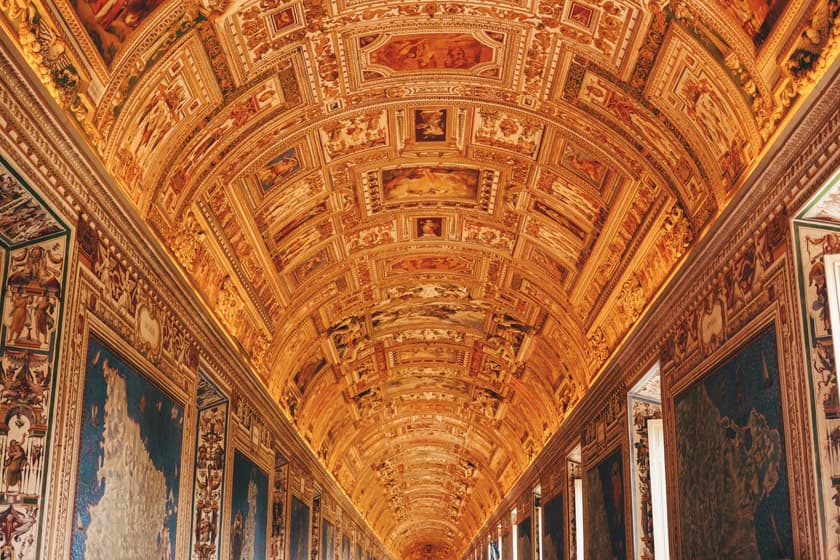
Vatican Museums
Another great travel attraction on the map of Rome is the Vatican. If you think about important museums, it’s hard not to think of the Vatican. Other galleries may have thousands of exhibits, but none can offer works of art that include entire rooms painted by Raphael and frescoes on the ceiling of the Sistine Chapel. The exhibitions are spread through several museums and hundreds of rooms, and to visit them all you have to travel about 8 kilometers.
Visit the main objectives – the Pio-Clementino Museum, the Sistine Chapel, the Rafael Rooms and the Pinacoteca (painting gallery), then see the museums that arouse your interest. This means that you can choose between the exhibition of ancient Egyptian art of the Gregorian Egyptian Museum and the Etruscan art exhibition of the Etruscan Greogriano Museum. Or it can mean choosing between rooms dedicated to modern or pagan art, admiring valuable tapestries and manuscripts, wandering colorfully full of old maps or through rooms full of medieval furniture and classical sculpture. Whatever you choose, allocate a lot of time and try to come early – in the middle of the tourist season, the queues can be terribly long.
Vatican museums have enough classical sculptures to last for a lifetime. If you want to see the most beautiful ones, go directly to the Pio-Clementino Museum, built in the 17th century by Pope Pius V and Pope Clement XIV. The most remarkable pieces of the museum are exhibited in the “Cortile Ottagono”, or the Octagonal Court.
Here you will see the famous “Laocoon”, sculpted on the island of Rhodes in 50, but rediscovered near the Colosseum in 1506. The work greatly influenced Renaissance art, as did another work in the court, the famous “Apollo Belvedere”, a Roman sculpture from 130 copied from an ancient Greek work from 330 BC.
Other interesting things you should see are:
- “Apoxyomenos” (which translates to “the one that cleans himself”) depicting a fighter who cleans his body of dust and sweat after a match.
- A sculpture from the 1st century, “Belvedere Torso”, a work that impressed Michelangelo a lot.
- A statue of Hermes depicting him throwing his cloak over his shoulder.
- The statue of “Apollo Sauroktonos” when the god is about to kill a lizard.
- Canova’s neoclassical work, “Perseus” (1800), and the Barberini chandeliers.
- A pair of 2nd-century lamps from Hadrian’s villa at Tivoli.
Stanze di Raffaello
In 1503, Pope Julius II commissioned the young Raphael, then 26, to decorate a small group of four rooms in the Vatican. The result was Stanze di Raffaello (Raphael’s Rooms), one of the supreme masterpieces of Western European art.
The first room he painted was the Stanza della Segnatura (1508-1511), the library of Pope Julius, and the place where important documents were signed. The four main paintings here explore the themes of theology, photography, philosophy, and justice, each intertwined with classical, religious, and contemporary characters and allusions.
Then, Raphael moved to Stanza d’Eliodoro (1512-1514), a private antechamber where the main quartet of paintings explores the theme of Divine Providence intervening to defend the Faith. During this time, a new pope ascended the Vatican, Pope Leo X. Therefore, one of the paintings depicts a scene from “Leon I rejecting Attila the Hun”. The insistence with which Leon demanded that his illustrious name be included in the painting was motivated by the fact that the pope wanted to secure his glory for eternity. This form of promotion completely devoid of subtlety continues in the third room.
In the third room, Stanza dell’ Incendio del Borgo (1514-1517), most of the paintings include the previous popes Leon, although the theme of the painting attracts less attention than the way of working, which reveals Raphael’s painting in a style much grander than in the previous rooms, the colors are more virulent, the emphasis on the human figure is much more marked. It is said that this change is due in large part to the influence of Michelangelo, who was then working nearby at the Sistine Chapel. The development of Raphael’s style was suddenly interrupted by his untimely death in 1520 so that only one painting in the last room was made according to his sketches.
Sistine Chapel
The most beautiful masterpiece of art on the map of Rome, came to life in the form of a modest chapel, built for Pope Sixtus IV in 1473. The first decoration of the chapel began in 1481 when the bottom of the walls was painted by a group of famous artists. , including Botticelli, Perugino, Pinturicchio, and Luca Signorelli. The now-famous ceiling remained unpainted until 1508 when Pope Julius II approached Michelangelo, who made one of his famous works.
It took four years for the work to be completed, four years in which Michelangelo had to work in very difficult conditions – from extreme temperatures and weeks of painting in tormented positions, lying on his back. More than 300 characters populate the scenes, which divide the work into nine main scenes. Each is read chronologically, in the order in which they walk through the chapel. First are the main events in the Book of Genesis:
- “Separation of Darkness from Light”
- “Creation of Heaven and Earth”
- “Separation of the Land of Water”
- “Creation of Adam”
- “Creation of Eve”
- “Sin and Expulsion from Paradise”
- “Noah’s Sacrifice”
- “The Flood”
- “Noah’s Drunkenness”
Rome was a special city, and Michelangelo was a special man when he came to paint the other masterpiece of the Sistine Chapel, the huge fresco of the “Last Judgment” (1534-1541), which covered the wall at the end of the chapel. More than 20 years of work on the chapel vault took place, during which time Rome was devastated by the robbery of the city by Charles V. Michelangelo was accused, among other things, of executing the tomb of Pope Julius II, his former patron.
As a result, his vision of the “Last Judgment” is black and uncompromising, the content is a departure from the initial interpretations of the theme, in which forgiveness and redemption are intertwined with divine revenge and anger. Sinners are depicted to the right of the painting, their bodies and faces contorted with terror, while the saved — rather relieved than delighted in their salvation — rise strongly to the left of the painting.
Other attractions in Vatican
The smallest museum of the Vatican, but with a special charm is the Pinacoteca, or art gallery, whose over 20 rooms include the cream of the crop of medieval and renaissance painting collection.
The best-known paintings here are Raphael’s last works, such as “The Transfiguration” (1517), “Our Lady of Foligno” (1512) and Giotto’s “Stefaneschi Triptych”, Caravaggio’s “Testimony” and the Portrait of Pope Sixtus 6 and his librarian, Platina, made by Melozzo da Forli. The gallery also houses the only painting by Leonardo da Vinci in Rome, a monochrome, unfinished work of St. Jerome, as well as works by almost all Italian or European artists.
If you have time, don’t forget to check out:
- “Galleria delle Carte Geografiche” (Gallery of Geographical Maps), whose walls are decorated with 40 painted maps (1580).
- “Cappella di Niccolo V”, in the vicinity of Raphael’s Rooms, contains frescoes about “The Life of St. Stephen and St. Laurentiu” (1447-1451), made by Fra Angelico.
- The “Gregorian Etruscan Museum” boasts the most famous collection of Etruscan art in the world, after Villa Giulia.
- The “Gregorian Egyptian Museum” is a treasure trove of Egyptian artifacts.
Villa Borghese – Museo e Galleria Borghese
If you look at the northern side of the map of Rome, you will find Villa Borghese. The open spaces and shady alleys of Rome’s central park are a real treat after the avalanche of wonderful views of the city center. They are also home to two of the most important museums: the Galleria Borghese, full of priceless paintings and sculptures, and Villa Giulia, considered worldwide as the largest museum of Etruscan art and artifacts.
The park, the most beautiful in Rome, was originally built between 1613 and 1616 for the Borghese family to have a shady and cool place to retreat during the hot summers in Rome. Today, lakes, fountains, forests, and lawns make it the ideal place for a walk or a nap. It offers you a lot of possibilities to get rid of the crowds, even on Sundays, when the park is the busiest.
Galleria Borghese was, at first, the “casino” of Villa Borghese (“casino” means “small house”), the name given in Italy to the main building of a country property. The association of this word, later, with gambling comes from the fact that the main concern of the occupants of these houses was to play. Although smaller than other museums, the Borghese collection is considered to be the most enchanting.
Many of the works were commissioned by Cardinal Scipione Borghese, the grandson of Pope Paul V, and purchased by the state in 1902. Scipione was a great protector of Bernini, one of the leading representatives of the Baroque current, whose works dominate. the sculpture section of the museum. However, the most famous sculpture is by Antonio Canova: an erotic statue of Paolina Borghese (1805-1808), Napoleon’s sister, and Camillo Borghese’s wife.
Among the many valuable paintings, you will find works by Raphael, Titian, Botticelli, and Caravaggio.
As you can see on the map of Rome, next to it, Villa Giulia was built as a recreation palace for Pope Julius III, a sculpture collector so obsessed that at his death in 1555, about 160 boats carried, up and down the Tiber, the sculptures. taken from the palace. Today, the artistic brilliance of the villa is a little different, but the quality of all the pieces on display – belonging to almost all Etruscan culture – is almost as amazing.
The Etruscans and their art are not to everyone’s taste, but you will find many things to admire here if you ignore the endless series of funeral urns. The most notable pieces are the terracotta statues of Apollo and Heracles, the tomb of Bernadini and a 6th-century sculpture, “Sarcofago degli Sposi”, a statue of a lying couple with an enigmatic smile.
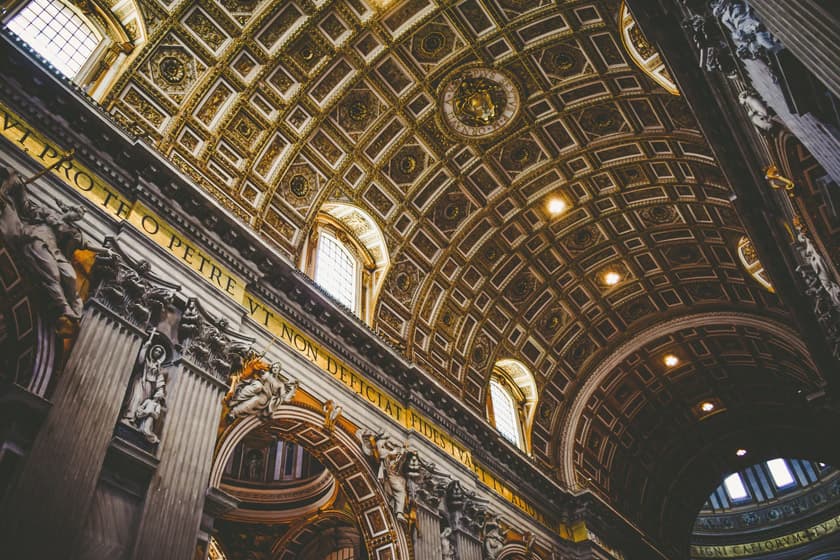
Saint Peter’s Basilica – Basilica di San Pietro
It is impossible not to be impressed by the Basilica di San Pietro (St. Peter’s Basilica): it is the largest church (it can accommodate about 60,000 people), represents the heart of Roman Catholicism, serves as a starting point for pilgrimages and is endowed with an amazing dome, designed by Michelangelo, offering a breathtaking view of a large part of the Eternal Citadel. The church owes its position and spiritual legitimacy to the apostle Peter, the first pope, who is believed to have been buried here after his crucifixion in 64 or 67, in the Imperial Gardens, not far from the church.
Around 135, or earlier, it seems that an altar was built here, but the first documented church was started around 326 by Pope Sylvester I, during the reign of Constantine the Great, the first Christian emperor.
This church lasted until 1452 when its precarious condition determined Pope Nicholas V to begin building a new one. It took almost two hundred years for the new home to be completed. During this time, the best architects of the time made a lot of successive plans or left the projects half unfinished.
The first significant proposal came from Bramante in 1506, a project that provided for a construction around the church, arranged in the shape of a Greek cross. The next project was by Antonio da Sangallo in 1539, but it was a plan that required the modification of ongoing work to make a church whose sketches were based on the shape of the Latin cross. Rafael, Baltassare Peruzzi, and Giuliano da Sangallo contributed. In 1576 it was the turn of Michelangelo, who was 72 years old, called to put together the project that was becoming more and more confusing. Immediately, Michelangelo set aside Sangallo’s project and began work on building the dome – both the bell tower and the two distinctive columns of the dome are his work.
In 1605, Carlo Madeno reinstalled the Latin cross and widened the facade, bringing it closer to its current appearance. Then Bernini created the magnificent square – Piazza San Pietro – and made some minor changes to the interior. The shrine was finally consecrated in 1626 by Pope Urban VIII, exactly 1300 years after the construction of the original church.
Basilica
Bramante kept very few elements from the original church, for which he was nicknamed Bramante-Ruinante (Bramante the Destroyer). Among the few elements that escaped the zeal of modernization were the central doors and a fragment of the mosaic above them, on the inner arch. The latter is the creation of Giotto and depicts the vessel of the apostles, “Navicella”, and Christ walking on the waters. Coincidentally, the Porta Santa, the farthest door of the five doors of the basilica, is usually opened only once every 25 years in the Holy Years.
The equestrian statues that flank the doors depict Charlemagne and Constantine and are Bernini’s creation.
Once inside the church, the first thing that takes your breath away is the impressive size, then you will marvel at the marble waterfalls, the sober tombs, and the multitude of baroque decorations and you will realize that the interior is devoid of great works of art. A notable exception is the statue of Michelangelo, “Pieta” (1499), placed in the first chapel in the southern nave.
Walking through the church, you will notice the size between the naves and you will find markings that show these sizes of another church compared to those of St. Peter’s Basilica. The intersection of the arms of the cross is dominated by the unmistakable grandeur of the altar vault, a piece created by Bernini, who used molten bronze from the ancient atrium of the Pantheon. Behind him, at the back of the church, is the Cathedra Petri (1656), another work by Bernini, an ornate throne that surrounds a wooden chair inlaid with ivory, which is said to have stood by St. Peter when he gave his first sermon. Romans.
On the other side of the cathedral are two of the most remarkable agglomerations of tombs and statues. On the left is the tomb of Pope Urban VIII (1647), made by Guglielmo della Porta, a model for the countless funerary monuments that followed.
The bronze statue of Saint Peter, attributed to Arnolfo di Cambio, and placed in front, on the right side, at the intersection of the four pillars, should not be missed either. It is a work of art that you cannot miss, thanks to the right foot, caressed by millions of people since Pope Pius IX granted 50 years of indulgence to those who will kiss the foot, after confession.
Finally, don’t forget to explore the so-called Vatican Caves, rooms in the basement of the church, full of graves, or, not least, to climb the dome for an unforgettable view of St. Mark’s Square and the city.

The map of Rome: Pantheon
After the romantic, but devastated beauty of the forum and the ruined grandeur of the Colosseum, the sheer grandeur of the Pantheon brings to Rome the strongest illustration of what the old city must have looked like. It is located in the center of the map of Rome, and from here you can easily reach other tourist attractions, the most important being Santa Maria sopra Minerva, a remnant of medieval times among the many Baroque churches in Rome, and the church of San Luigi dei Francesi, well known for a Cavaraggio’s exceptional tryptic.
Emperor Hadrian completed the Pantheon in 128 – probably according to his own sketches – replacing much of a temple built on that site in 27 by Marcus Agrippa, the son-in-law of Emperor Augustus. Hadrian kept the impressive inscription on the façade that attributed the construction of Agrippa: the Latin text said: “Marcus Agrippa, son of Lucius, consul for the third time, built this.”
The miraculous state of preservation of the building kept it from changing when it was transformed into a Christian church in 609, a transformation that ensured that the removal of even a single stone is a mortal sin. On November 1, the same year, the church was christened Santa Maria ad Martyres (Virgin and All Martyrs), a day commemorated since then as All Saints’ Day.
Today, the building is still the church, and both the interior and the exterior look exactly as they were in the 2nd century. Not all the marble inside is the original one, although the shape and the way they were matched are supposed to conform to Hadrian’s sketches. Along the walls are the tombs of the painter Raphael and two Italian kings, Umberto I and Victor Emanuel I.
The dome is a masterpiece of Roman engineering. Larger than that of St. Peter’s Basilica, it was the most imposing concrete construction until the 20th century and the largest unsupported vault in the world until 1960. “Ocullus”, the eye of the dome, the middle hole that opens to heaven, was a key element of Hadrian’s original plan, its purpose being both practical – helps to illuminate the interior – and spiritual, allowing those in the temple a direct contemplation of the heavens.
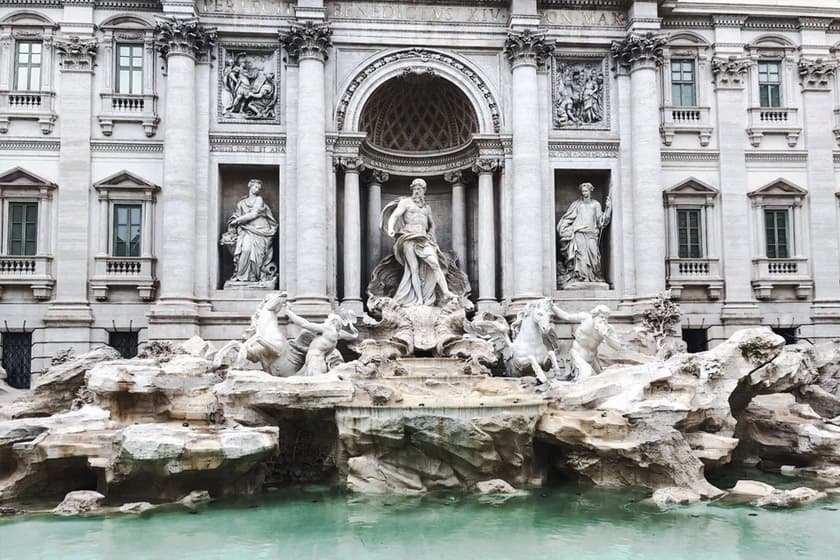
Trevi Fountain – Fontana di Trevi
The map of Rome highlights another famous tourist attraction, the Trevi Fountain. The first fountain in this place was built in 1453 for Pope Nicholas V and was supplied with water from the Acqua Vergine, an aqueduct built by Agrippa in 19. The current fountain, inspired by the Arch of Constantine, was built between 1732 and 1762 for Pope Clement XII, probably after a project by Nicola Salvi (1697-1751). Few places in Rome are so enchanting at first glance, the cobbled and narrow streets suddenly opening, revealing the “fountain” placed along an entire wall of Palazzo Poli. The name of the fountain comes from the three streets that meet here.
In the center of the fountain is a statue of “Oceanus” (Neptune), flanked by riding newts, which symbolizes a stormy sea (on the left) and a calm sea (on the right). The statues in the niches behind Neptune represent Health and Abundance, and the statues on the pediment of the fountain, the four seasons and their gifts.
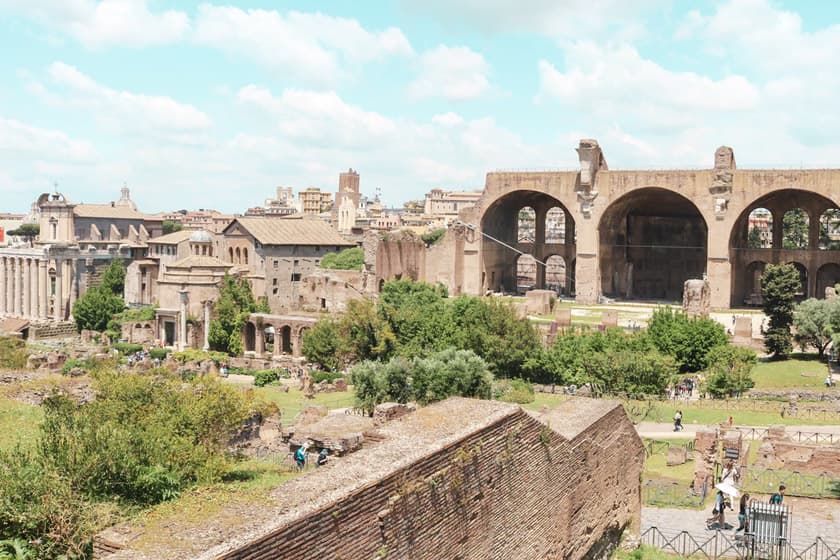
The Roman Forum – Foro Romano
A famous tourist attraction on the map of Rome is the Roman Forum. For almost a thousand years, the Foro Romano (Roman Forum) was the heart of Ancient Rome and the brain of an empire that stretched across almost every territory known to Europeans. Today, all that remains is a mixture of Roman ruins, although their nostalgic beauty and immensity of historical resonance still make this place the most important archaeological site in Europe. Destroyed and rebuilt over the centuries, its historical monuments – stacked on top of each other – often cause confusion. Don’t expect to be overwhelmed by the ancient grandeur – but come and enjoy the splendors of the past and the charm of once great places.
The forum was originally a swampy valley between the Palatine Hill and the Capitol Hill. During the Iron Age, it was the cemetery on the edge of a village, a destination that probably gave the place its name (“forum” in Latin means “outside”). Later it became a landfill for settlements in the area and much later, the communal market. The first monuments probably appeared in the 7th century BC, during the reign of the first Etruscan kings. As the empire flourished, the forum accumulated all the structures of civic, religious, and political life. Patrick’s houses, shops, temples, and markets fought for space, and merchants, politicians, and emperors competed to fill the area with increasingly beautiful monuments.
By the 2nd century BC, the construction frenzy took its course but widened its area because all the original space had been occupied. The forum remained a symbolic focal point, despite the transfer of political power to the Palatine Hill, the comet to the Mercato Traiano (Trajan’s Square), and new buildings to the Imperial Forums. After the fall of the Roman Empire, time began to make its mark. In the 3rd century, fires ravaged the city. The earthquakes and attacks of the barbarian invaders from the 5th century followed. During the Middle Ages, the stone was stolen for the construction of churches and palaces and the precious marble was dusted in the lime kilns of the builders. Eventually, the forum shrank so much that it became known as the “campo vaccino,” or pasture for cows. Controlled excavations began only in the 17th century and continue today.
Make sure you enjoy a panoramic view of the forum before you start exploring. You have the best view from Via del Campidoglio and behind Palazzo Senatorio in Piazza del Campidoglio. You need a good map of the place and a lot of imagination to see what the ruins represent. You still need a guide, but only for the most representative and best-preserved monuments.
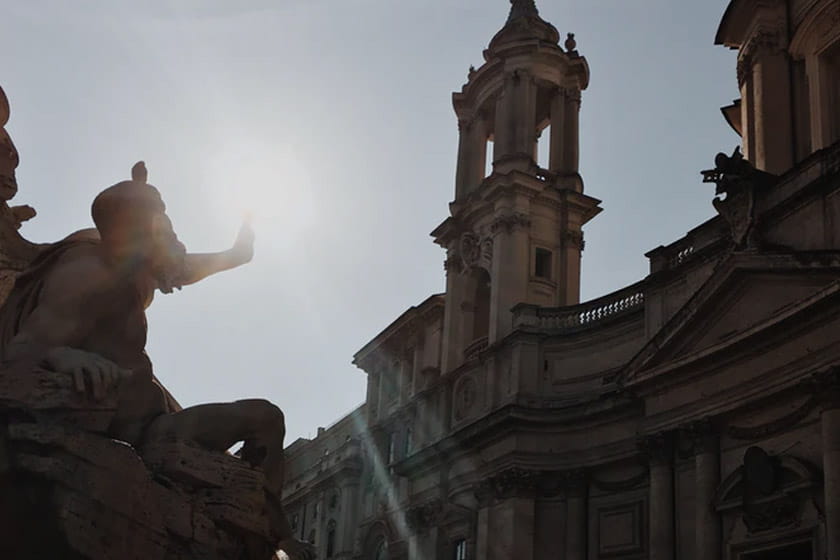
Although the map of Rome has a lot of plazas, Piazza Navona is the most enchanting square in Rome, a natural magnet that attracts visitors day and night, an ideal place to spend an hour looking at people while sitting at a table in one of the many cafes here. With an ellipse-like shape, the outline of the square resembles that of the Circus Agonalis – hence its name – a huge stadium with 30,000 seats, inaugurated by Emperor Domitian in 86.
The square underwent the greatest transformations in 1644 when Pope Innocent X began a radical program of Baroque reconstruction. Among the monuments made, two fountains, Bernini’s creation, stood out: the Fontana del Moro (at the southeast end of the square) and the one in the center Fontana dei Quattro Fiumi, or the Fountain of the Four Rivers. The statues symbolize the four rivers of Paradise, the Danube, the Nile, the Rio de la Plata, and the Ganges, and those four corners of the known world – Asia, Africa, Europe, and America.
As you can see on the map of Rome, to the west of the square is the church of Sant’Agnese, with a concave facade made by Bernini’s greatest rival, Francesco Borromini. The building stands on the site of the martyrdom of Saint Agnes, a 13-year-old virgin who was killed for refusing to marry a pagan. Next to it is one of the many palaces of Pope Innocent X, Palazzo Doria Pamphilj.
Campo de Fiori
In Campo de’Fiori (Field of Flowers) there are wonderful fairs every day, except Sunday. The square is filled with fruits, fish, flowers, and vegetables placed on stalls or in shops that look as if they were taken from a film by Fellini.
Campo de’Fiori does not have a church – a rare thing in Rome. It has long been one of the poorest neighborhoods: here, Cavaraggio killed an acquaintance of his after losing a tennis match. Nothing better symbolizes the secular nature of the square than the statue of Giordano Bruno – humanist and philosopher, condemned for heresy and burned at the stake in this square in 1600.
Piazza Farnese, a bright square in the south, brings a balance compared to the more rigid charm of Campo Square. In Farnese Square, everything is decorated and refined due, in particular, to the Farnese Palace (Palazzo Farnese) (1515), whose facade is the work of Michelangelo. Today, it is the headquarters of the French Embassy. Be sure not to miss Villa Giulia, one of the most elegant streets in Rome, which is behind the palace.
Map of Rome: Conclusions
The map of Rome, it is filled with tourist attractions, historic sites, and architectural wonders. These make Rome a unique city and a definite tourist destination. Besides the well-known attractions, you should definitely check the smaller ones as they are as beautiful as the famous tourist attractions.
If you want to find out more, check out the official Rome website, and for other destinations in the Italian Peninsula, check out my article travel guide and the map of Italy.
Did you find this article helpful? If you did, share it with your friends on social media. Maybe it can help them too. Who knows, maybe someone already planned a holiday in Rome.
We recommend checking out our article about the most beautiful waterfalls in Italy.





